Targeting
Target the right audience that is actively searching for products like yours, right when they’re ready to buy. It’s possible with Amazon PPC keyword targeting.
By strategically selecting and refining your keywords, you can ensure your ads appear in front of the right customers, maximizing visibility and engagement. Keep reading for insights into the different keyword match types, from exact to broad match, and best practices for keyword research.
What is keyword research?
Keyword research is the process of identifying search terms customers use in search engines.
Keyword research is essential for identifying the most effective keywords to target and gaining insights into the search terms used by your audience. Choosing the right keywords for your brand or product is crucial for success in PPC campaigns. It’s recommended to select keywords with different search volumes based on your specific goals.
Types of Targeting
- Keyword targeting: for sponsored products, sponsored brands campaigns
- Product targeting: for sponsored products, sponsored brands campaigns, and sponsored brands displays
How to Use Keyword Targeting
Keyword targeting involves selecting words or phrases (keywords) likely used by potential buyers.
When customers search using these keywords, ads for the seller’s products appear in search results or product detail pages.
Sellers bid on these keywords, and if their bid is competitive, their ad is shown to customers, helping attract relevant traffic to their listings.
Example of Keyword Targeting in Amazon PPC
A wireless earbuds vendor might select “wireless earbuds” as a keyword. When a customer searches for “wireless earbuds,” their ad could appear in the search results or on relevant product detail pages, helping their product reach the right audience at the right time.
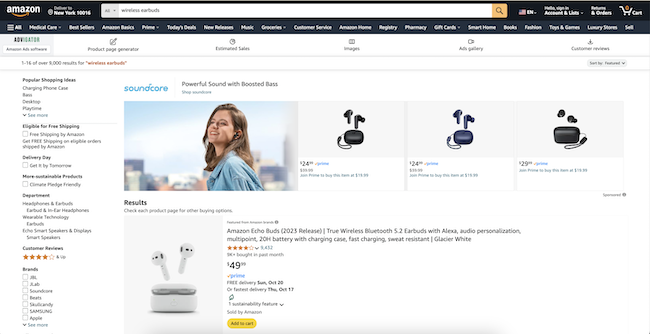
Understanding Product Targeting
Product targeting allows ads to appear on specific product pages or categories.
With product targeting, sellers can also choose to place their ads on pages of competitor products or complementary items, helping them reach customers already interested in related items.
This method is effective for directly comparing your product with others or placing your ad where customers are likely to purchase.
Product targeting example
If advertising a women’s running shoe from “Nike,” you could target the broader category of “women’s running shoes” across relevant search results and detail pages. You could also choose to target competitor “Adidas,” or even focus on specific factors like price ranges, customer reviews, or product variations.
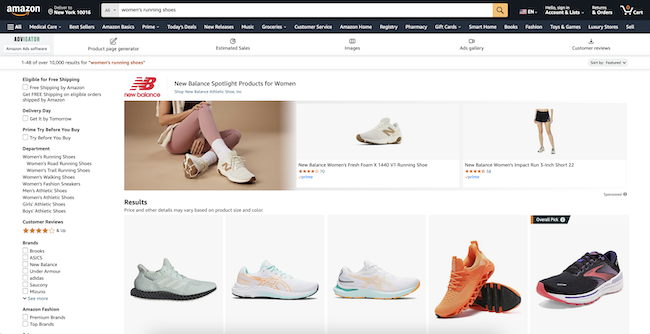
Negative Keyword Targeting
A negative match keyword is a term you choose to exclude from triggering your ads. This strategy ensures that your ads won’t appear on search results that are irrelevant to your campaign objectives.
There are two types of negative keyword targeting:
- Negative Phrase Match: Ads won’t appear for queries containing the full phrase.
- Negative Exact Match: Ads won’t appear for exact matching queries.
You can find negative keywords using the search term report
Types of Keyword Match Types
Choosing the right match type is as important as picking the right keywords.

Exact Match Keywords
Ads only appear when a shopper’s search query matches the keyword exactly.
This match type is the most restrictive, as it only triggers an ad when the search term closely mirrors the keyword you’re bidding on, is in the exact same order and without any extra words before, after, or between.
When to use exact match keywords
Exact match keywords are useful when you want to tightly control which searches trigger your ads, ensuring that you’re targeting highly relevant terms that are more likely to convert into clicks or purchases.
Exact match keyword example
If your exact match keyword is “sunscreen”, your ad will only appear if someone searches for that exact word, “sunscreen”. It won’t trigger for searches like “best sunscreen” or “sunscreen for sensitive skin”.
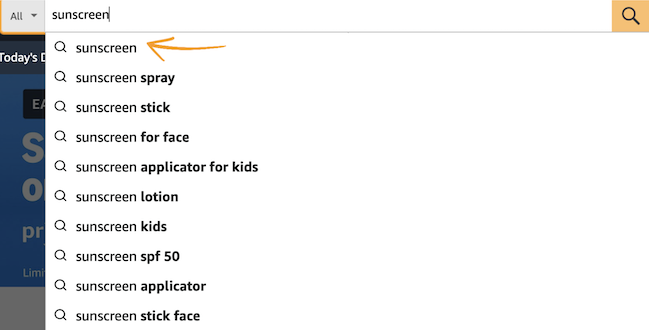
Phrase match keywords
For phrase keyword targeting, your ad can appear when a shopper’s search query contains your keyword in the same order, but it can also include additional words before or after the phrase.
This match type offers more flexibility than an exact match while still maintaining some level of control over relevancy.
When to use phrase match keywords
Phrase match is useful when you want to capture relevant search terms that include your main keyword but allow for slight variations in how shoppers phrase their queries.
Phrase match keyword example
For example, if your phrase match keyword is “sunscreen”, your ad can appear for searches like “best sunscreen”, “sunscreen for kids”, or “waterproof sunscreen”. However, it won’t trigger for searches where the words in the phrase are rearranged or split up, like “sensitive skin sunscreen”.

Broad Match Keywords
Broad match keywords are the most flexible type of keyword targeting. Your ad can appear when a shopper’s search query includes any combination of your keyword’s terms, related terms, synonyms, or variations, regardless of word order. This allows your ad to show for a wide variety of searches that are loosely connected to your keyword.
When to use broad match keywords
Broad-match keywords are useful when you’re looking to cast a wide net and attract a larger audience, allowing your ad to appear for a broader range of search terms that are still somewhat relevant to your product.
Broad match keyword example
For example, if your broad match keyword is “sunscreen”, your ad could appear for searches like “best sunscreen for sensitive skin”, “sunblock for the beach”, or “UV protection lotion”. Even variations and synonyms like “sun cream” or “sun lotion” might trigger your ad.
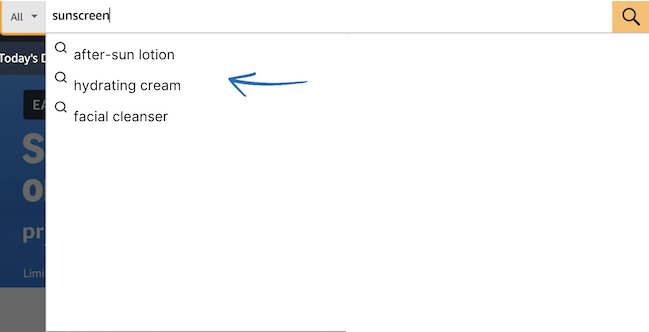
Broad+ (+ modifier)
Broad match modifier keywords allow for more control than a regular broad match but with greater flexibility than a phrase or an exact match.
By adding a ”+” symbol before specific words in your keyword, you ensure that those particular words (or their close variations) must be included in the shopper’s search query. Other words may appear before, after, or between your specified words, but the terms with the “+” sign must be present in the search.
When to use broad+ (+ modifier)
This match type is helpful when you want to target a wide range of search terms but still ensure certain key elements (like product features or attributes) are included in the shopper’s search.
Broad+ (+ modifier) example
If your keyword is +sunscreen +spray, your ad could appear for searches like “best spray sunscreen”, “waterproof spray sunscreen”, or “sunscreen spray for kids”. However, it wouldn’t show for searches like “best sunscreen” (because “spray” is missing) or “spray sunblock” (because “sunscreen” is required).
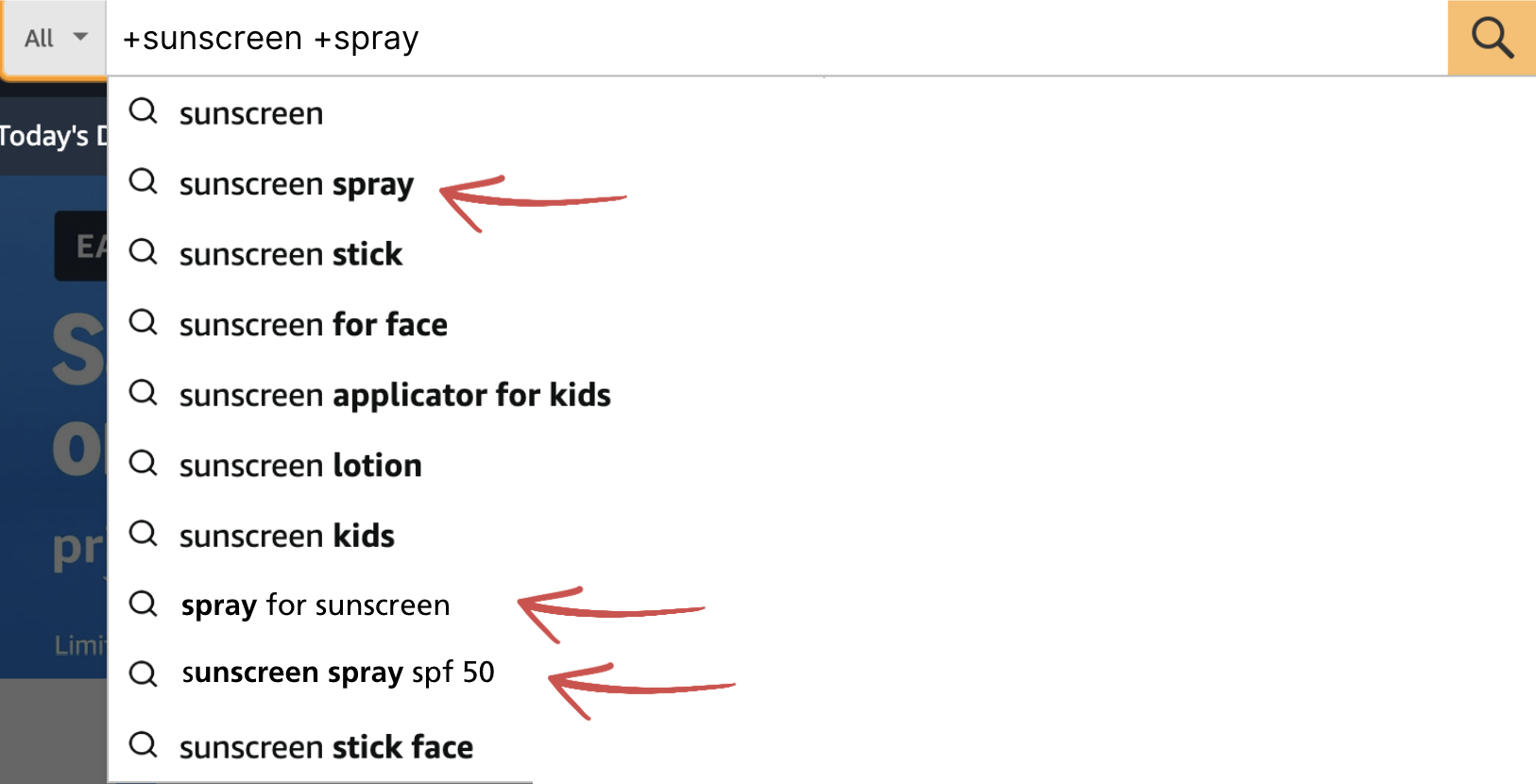
You can also combine several match types within a single campaign. This method can be useful for striking a balance between broad visibility and targeted precision.
For example, a campaign may use broad match types to maximize impressions while incorporating phrase and exact match types to ensure ads reach users searching for more specific keywords.
How to Find and Select the Best Keywords
There are several ways to find keywords to add to a campaign.
1. Amazon Keyword Targeting Tool
The tool integrated with Amazon automatically suggests keywords.

2. Amazon Autocomplete Search Bar
Amazon’s autocomplete is very useful because it suggests commonly searched terms. You should try different words and combinations to extract multiple keywords.

3. PPC Advertising Software
PPC advertising software like Advigator automatically suggest keywords when you activate the campaign based on several methods we already reviewed before.

4. Competitor product titles
Competitors have likely optimized their product titles for high-traffic keywords. You can leverage their efforts to identify the most relevant keywords.

5. Keyword Research Tools
Or you could use one of the many keyword research tools such as Helium 10. You provide an ASIN and it generates a list of keywords that you then have to filter and select only the most relevant ones.

Monitoring and Adjusting Your Campaign for Better Results
Review your campaign after two weeks. Optimize by archiving low-performing keywords, increasing bids on high-performers, and using reports to refine your strategy. PPC software can automate keyword optimization for better performance.
Staying proactive ensures you continue to target the best opportunities and maximize your campaign’s performance.
Launch optimized campaigns and leverage automation to keep them optimized over time. Easy to use for any Aamazon seller.
Get started